Slice of History - 45 Years Since Voyager 1’s Jupiter Closest Encounter

On 5 March 1979, Voyager 1 passed Jupiter for the first time in a landmark moment in global space history.
Designed to take advantage of a rare planetary alignment that occurs only once in 176 years, Voyagers 1 and 2 remain both the most distant human-made objects in existence and the most well-traveled spacecraft in history. Essentially Mariner 11, Voyager 1 continued to make headlines as it discovered new moons, active volcanoes, and a wealth of data about the outer solar system.
This press event even included various VIPs, including Sidney Poitier and Governor Jerry Brown, who is seen in this photo alongside Charles Kohlhase, taken at a press conference held for the Jupiter Closest Approach in March 1979. The two are discussing a scaled representation of Voyager 1’s closest approach to Jupiter. CL#23-6587
The content presented here should be viewed in the context of the time period. Our intent is to present the history of JPL in a factual manner that uses primary resources and historical context. We recognize that some information or images do not reflect the current values, policies, and mission of JPL.
Want to learn more about the history of JPL?

Keep Exploring

Suggested Searches
- Climate Change
- Expedition 64
- Mars perseverance
- SpaceX Crew-2
- International Space Station
- View All Topics A-Z
Humans in Space
Earth & climate, the solar system, the universe, aeronautics, learning resources, news & events.

NASA’s Commercial Partners Deliver Cargo, Crew for Station Science

Hi-C Rocket Experiment Achieves Never-Before-Seen Look at Solar Flares

NASA Is Helping Protect Tigers, Jaguars, and Elephants. Here’s How.
- Search All NASA Missions
- A to Z List of Missions
- Upcoming Launches and Landings
- Spaceships and Rockets
- Communicating with Missions
- James Webb Space Telescope
- Hubble Space Telescope
- Why Go to Space
- Astronauts Home
- Commercial Space
- Destinations
- Living in Space
- Explore Earth Science
- Earth, Our Planet
- Earth Science in Action
- Earth Multimedia
- Earth Science Researchers
- Pluto & Dwarf Planets
- Asteroids, Comets & Meteors
- The Kuiper Belt
- The Oort Cloud
- Skywatching
- The Search for Life in the Universe
- Black Holes
- The Big Bang
- Dark Energy & Dark Matter
- Earth Science
- Planetary Science
- Astrophysics & Space Science
- The Sun & Heliophysics
- Biological & Physical Sciences
- Lunar Science
- Citizen Science
- Astromaterials
- Aeronautics Research
- Human Space Travel Research
- Science in the Air
- NASA Aircraft
- Flight Innovation
- Supersonic Flight
- Air Traffic Solutions
- Green Aviation Tech
- Drones & You
- Technology Transfer & Spinoffs
- Space Travel Technology
- Technology Living in Space
- Manufacturing and Materials
- Science Instruments
- For Kids and Students
- For Educators
- For Colleges and Universities
- For Professionals
- Science for Everyone
- Requests for Exhibits, Artifacts, or Speakers
- STEM Engagement at NASA
- NASA's Impacts
- Centers and Facilities
- Directorates
- Organizations
- People of NASA
- Internships
- Our History
- Doing Business with NASA
- Get Involved
- Aeronáutica
- Ciencias Terrestres
- Sistema Solar
- All NASA News
- Video Series on NASA+
- Newsletters
- Social Media
- Media Resources
- Upcoming Launches & Landings
- Virtual Events
- Sounds and Ringtones
- Interactives
- STEM Multimedia

Hubble Hunts Visible Light Sources of X-Rays

NASA Selects Students for Europa Clipper Intern Program

NASA Mission Strengthens 40-Year Friendship

NASA Selects Commercial Service Studies to Enable Mars Robotic Science

Two Small NASA Satellites Will Measure Soil Moisture, Volcanic Gases

NASA-Led Study Provides New Global Accounting of Earth’s Rivers

Orbits and Kepler’s Laws

X-ray Satellite XMM-Newton Sees ‘Space Clover’ in a New Light

NASA/JAXA’s XRISM Mission Captures Unmatched Data With Just 36 Pixels

Researchers Develop ‘Founding Document’ on Synthetic Cell Development

ARMD Solicitations

NASA Uses Small Engine to Enhance Sustainable Jet Research

NASA Photographer Honored for Thrilling Inverted In-Flight Image

Big Science Drives Wallops’ Upgrades for NASA Suborbital Missions

Tech Today: Stay Safe with Battery Testing for Space

NASA Grant Brings Students at Underserved Institutions to the Stars

Washington State High Schooler Wins 2024 NASA Student Art Contest

Asian-American and Native Hawaiian Pacific Islander Heritage Month

Diez maneras en que los estudiantes pueden prepararse para ser astronautas

Astronauta de la NASA Marcos Berríos

Resultados científicos revolucionarios en la estación espacial de 2023
40 years ago: voyager 2 explores jupiter, johnson space center.
Forty years ago, the Voyager 2 spacecraft made its closest approach to Jupiter. Managed by the Jet Propulsion Laboratory in Pasadena, California, the Voyagers were a pair of spacecraft launched in 1977 to explore the outer planets. Initially targeted only to visit Jupiter and Saturn, Voyager 2 went on to investigate Uranus and Neptune as well, taking advantage of a rare planetary alignment that occurs once every 175 years to use the gravity of one planet to redirect it to the next. Although not the first to explore the giant planet, Pioneer 10 and 11 completed earlier flybys in 1973 and 1974, respectively, the Voyagers carried sophisticated instruments to conduct more in-depth investigations. Voyager 2’s twin, Voyager 1, made its closest approach to Jupiter in March 1979.
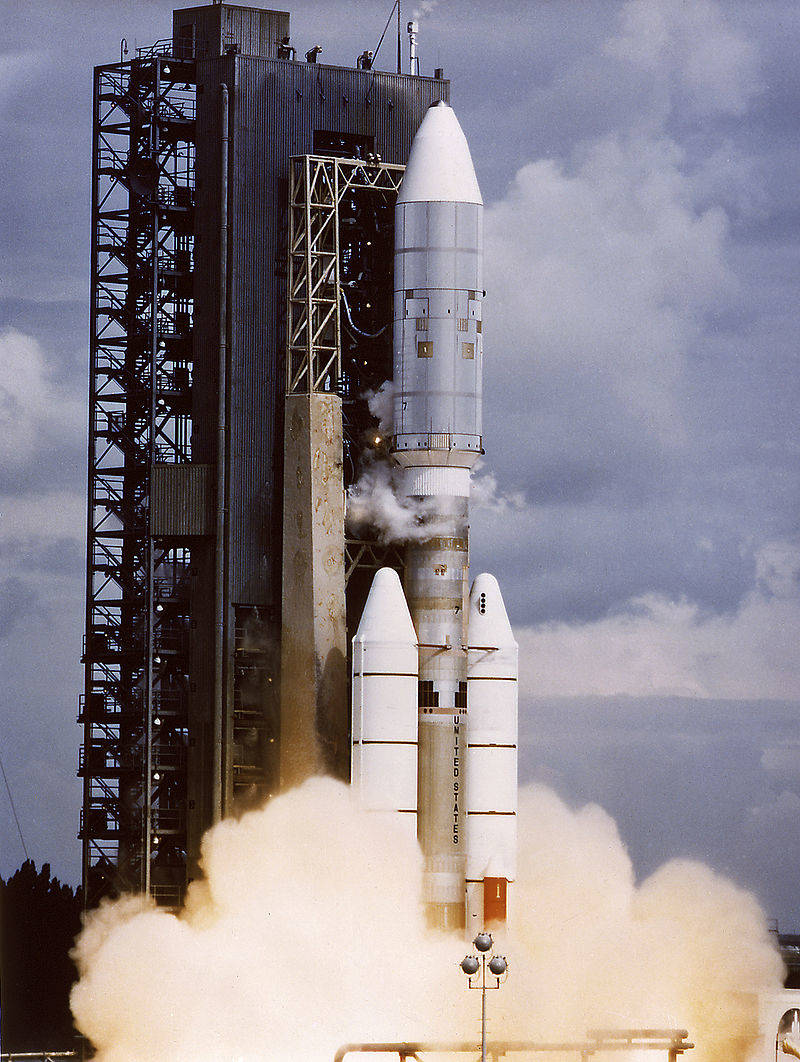
Each Voyager carried a suite of 11 instruments, including:
- an imaging science system consisting of narrow-angle and wide-angle cameras to photograph the planet and its satellites;
- a radio science system to determine the planet’s physical properties;
- an infrared interferometer spectrometer to investigate local and global energy balance and atmospheric composition;
- an ultraviolet spectrometer to measure atmospheric properties;
- a magnetometer to analyze the planet’s magnetic field and interaction with the solar wind;
- a plasma spectrometer to investigate microscopic properties of plasma ions;
- a low energy charged particle device to measure fluxes and distributions of ions;
- a cosmic ray detection system to determine the origin and behavior of cosmic radiation;
- a planetary radio astronomy investigation to study radio emissions from Jupiter;
- a photopolarimeter to measure the planet’s surface composition; and
- a plasma wave system to study the planet’s magnetosphere.
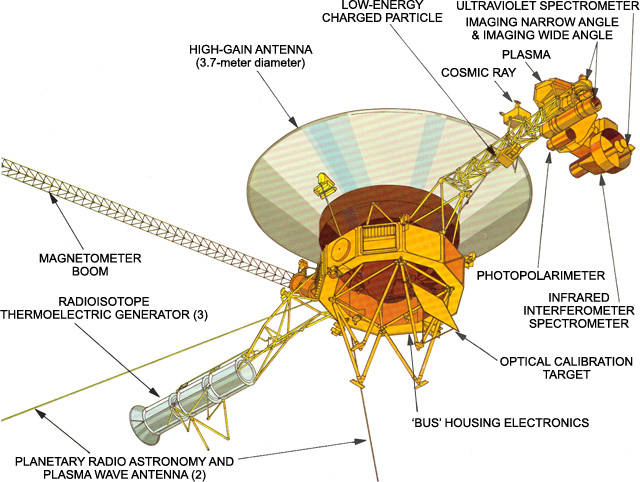
Voyager 2 was the first of the two spacecraft to launch, on Aug. 20, 1977. Although its twin launched two weeks later, it was on a faster trajectory and arrived at Jupiter four months earlier. Voyager 2 successfully crossed the asteroid belt between Dec. 10, 1977, and Oct. 21, 1978. In April 1978, its primary radio receiver failed, and it has been operating on its backup receiver ever since. The spacecraft began its encounter phase with the Jovian system on April 24, 1979, sending back its first images and taking the first science measurements.
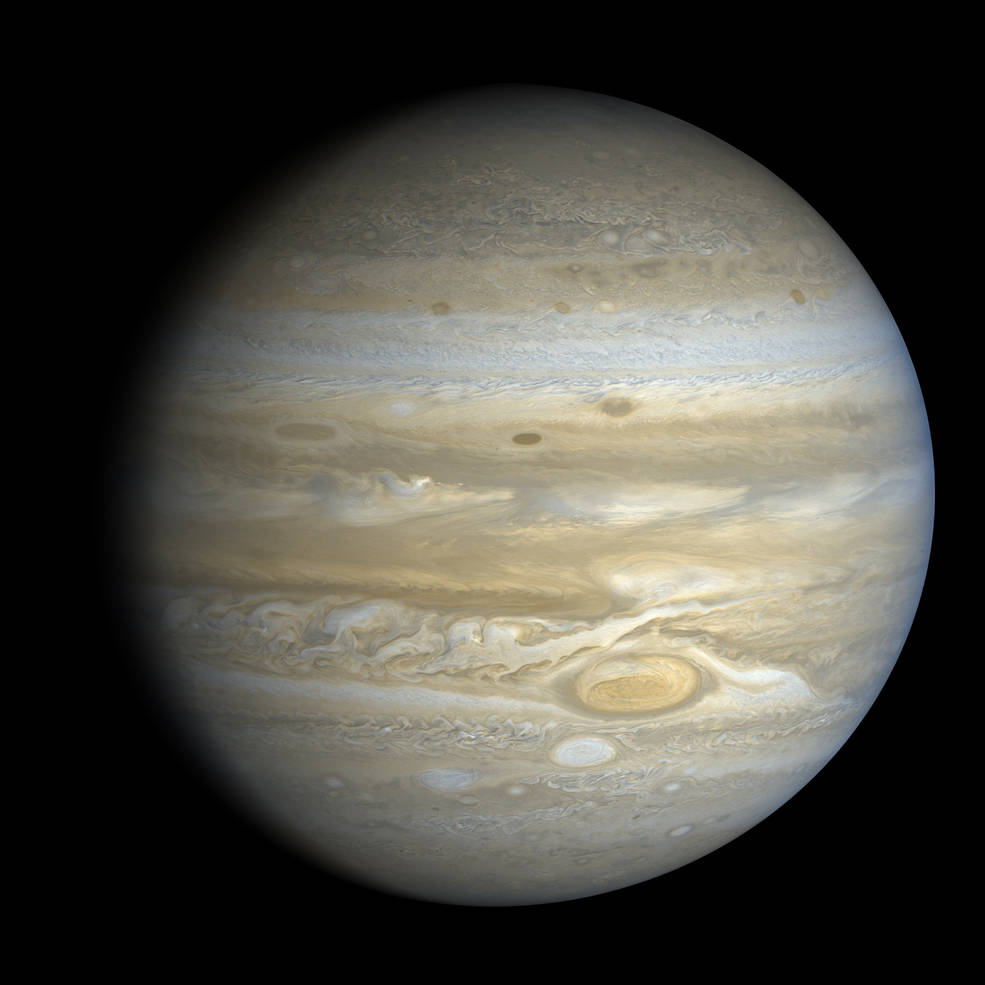
During its inbound journey toward the planet, Voyager 2 made flybys of several of Jupiter’s moons – 133,600 miles of Callisto, 38,600 miles of Ganymede, 127,900 miles of Europa, and 347,000 miles of Amalthea. On July 9, 1979, Voyager 2 made its closest approach to Jupiter, flying within 350,000 miles of the planet’s cloud tops. On the outbound leg of its encounter, it imaged the satellite Io (closest approach of 702,200 miles), and conducted a 10-hour volcano watch of the moon, confirming Voyager 1’s finding that it harbored active volcanoes. Voyager 2 revealed the Great Red Spot to be a complex storm system, and also imaged several smaller storms in the planet’s atmosphere. High-resolution photographs of Europa revealed extensive irregular markings on its surface, possibly indicating a frozen crust floating atop a deep ocean. Looking back at Jupiter as it was backlit by the Sun, Voyager 2 confirmed the existence of a thin ring surrounding the planet. Voyager 2 also discovered a previously unknown moon, later named Adrastea, orbiting Jupiter just outside its rings. By the time observations of Jupiter concluded on Aug. 5, the spacecraft had returned 17,000 images of the planet and its satellites.
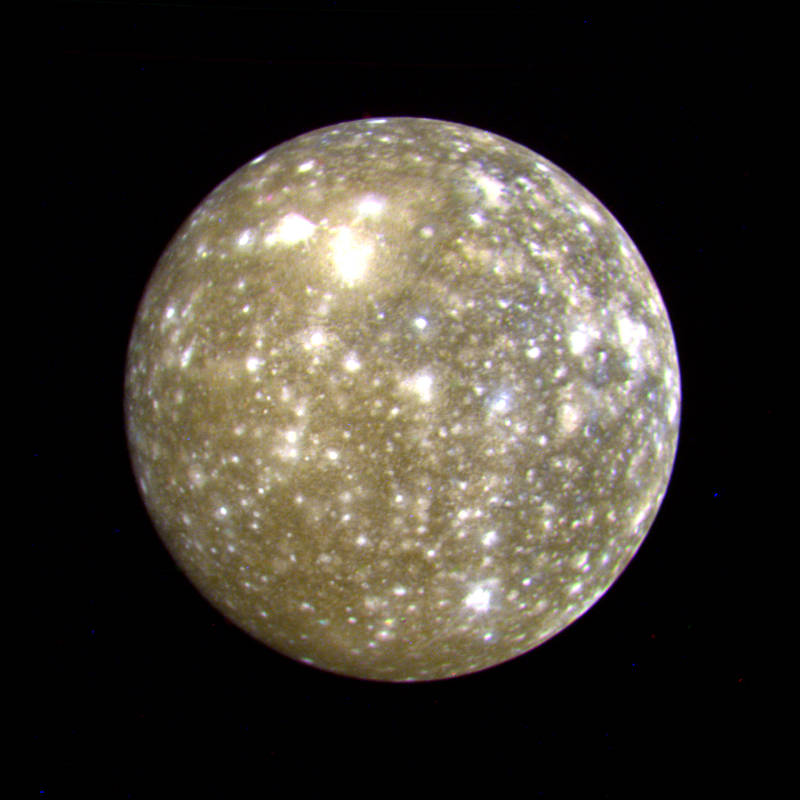
After its successful exploration of the Jovian system, Voyager 2 sailed on toward Saturn. During its encounter in August 1981, the spacecraft returned a wealth of information about the planet, its spectacular rings, and its satellites. Saturn’s gravity altered Voyager 2’s trajectory to send it to encounter Uranus in January 1986, where it carried it out the first the first reconnaissance of that planet, its satellites, and its rings. In turn, Voyager 2 picked up a gravity assist at Uranus to send it to its final planetary encounter with Neptune in August 1989. Following its reconnaissance of Neptune, Voyager 2 began its Interstellar Mission extension that continues to this day. Over the years, several of the spacecraft’s instruments have been turned off to conserve power, beginning with the imaging system in 1998, but it continues to return data about cosmic rays and the solar wind. On Nov. 5, 2018, six years after its twin, Voyager 2 crossed the heliopause, the boundary between the heliosphere, the bubble-like region of space created by the Sun, and the interstellar medium. It is expected that Voyager 2 will continue to return data from interstellar space until about 2025. And just in case it may one day be found by an alien intelligence, Voyager 2 like its twin carries a gold plated record that contains information about its home planet, including recordings of terrestrial sounds, music and greetings in 55 languages. Instructions on how to play the record are also included.
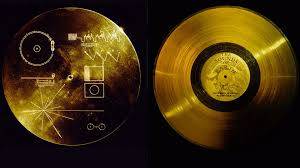
Inside NASA's 5-month fight to save the Voyager 1 mission in interstellar space

After working for five months to re-establish communication with the farthest-flung human-made object in existence, NASA announced this week that the Voyager 1 probe had finally phoned home.
For the engineers and scientists who work on NASA’s longest-operating mission in space, it was a moment of joy and intense relief.
“That Saturday morning, we all came in, we’re sitting around boxes of doughnuts and waiting for the data to come back from Voyager,” said Linda Spilker, the project scientist for the Voyager 1 mission at NASA’s Jet Propulsion Laboratory in Pasadena, California. “We knew exactly what time it was going to happen, and it got really quiet and everybody just sat there and they’re looking at the screen.”
When at long last the spacecraft returned the agency’s call, Spilker said the room erupted in celebration.
“There were cheers, people raising their hands,” she said. “And a sense of relief, too — that OK, after all this hard work and going from barely being able to have a signal coming from Voyager to being in communication again, that was a tremendous relief and a great feeling.”

The problem with Voyager 1 was first detected in November . At the time, NASA said it was still in contact with the spacecraft and could see that it was receiving signals from Earth. But what was being relayed back to mission controllers — including science data and information about the health of the probe and its various systems — was garbled and unreadable.
That kicked off a monthslong push to identify what had gone wrong and try to save the Voyager 1 mission.
Spilker said she and her colleagues stayed hopeful and optimistic, but the team faced enormous challenges. For one, engineers were trying to troubleshoot a spacecraft traveling in interstellar space , more than 15 billion miles away — the ultimate long-distance call.
“With Voyager 1, it takes 22 1/2 hours to get the signal up and 22 1/2 hours to get the signal back, so we’d get the commands ready, send them up, and then like two days later, you’d get the answer if it had worked or not,” Spilker said.

The team eventually determined that the issue stemmed from one of the spacecraft’s three onboard computers. Spilker said a hardware failure, perhaps as a result of age or because it was hit by radiation, likely messed up a small section of code in the memory of the computer. The glitch meant Voyager 1 was unable to send coherent updates about its health and science observations.
NASA engineers determined that they would not be able to repair the chip where the mangled software is stored. And the bad code was also too large for Voyager 1's computer to store both it and any newly uploaded instructions. Because the technology aboard Voyager 1 dates back to the 1960s and 1970s, the computer’s memory pales in comparison to any modern smartphone. Spilker said it’s roughly equivalent to the amount of memory in an electronic car key.
The team found a workaround, however: They could divide up the code into smaller parts and store them in different areas of the computer’s memory. Then, they could reprogram the section that needed fixing while ensuring that the entire system still worked cohesively.
That was a feat, because the longevity of the Voyager mission means there are no working test beds or simulators here on Earth to test the new bits of code before they are sent to the spacecraft.
“There were three different people looking through line by line of the patch of the code we were going to send up, looking for anything that they had missed,” Spilker said. “And so it was sort of an eyes-only check of the software that we sent up.”
The hard work paid off.
NASA reported the happy development Monday, writing in a post on X : “Sounding a little more like yourself, #Voyager1.” The spacecraft’s own social media account responded , saying, “Hi, it’s me.”
So far, the team has determined that Voyager 1 is healthy and operating normally. Spilker said the probe’s scientific instruments are on and appear to be working, but it will take some time for Voyager 1 to resume sending back science data.
Voyager 1 and its twin, the Voyager 2 probe, each launched in 1977 on missions to study the outer solar system. As it sped through the cosmos, Voyager 1 flew by Jupiter and Saturn, studying the planets’ moons up close and snapping images along the way.
Voyager 2, which is 12.6 billion miles away, had close encounters with Jupiter, Saturn, Uranus and Neptune and continues to operate as normal.
In 2012, Voyager 1 ventured beyond the solar system , becoming the first human-made object to enter interstellar space, or the space between stars. Voyager 2 followed suit in 2018.
Spilker, who first began working on the Voyager missions when she graduated college in 1977, said the missions could last into the 2030s. Eventually, though, the probes will run out of power or their components will simply be too old to continue operating.
Spilker said it will be tough to finally close out the missions someday, but Voyager 1 and 2 will live on as “our silent ambassadors.”
Both probes carry time capsules with them — messages on gold-plated copper disks that are collectively known as The Golden Record . The disks contain images and sounds that represent life on Earth and humanity’s culture, including snippets of music, animal sounds, laughter and recorded greetings in different languages. The idea is for the probes to carry the messages until they are possibly found by spacefarers in the distant future.
“Maybe in 40,000 years or so, they will be getting relatively close to another star,” Spilker said, “and they could be found at that point.”
Denise Chow is a reporter for NBC News Science focused on general science and climate change.
- Mobile Site
- Staff Directory
- Advertise with Ars
Filter by topic
- Biz & IT
- Gaming & Culture
Front page layout
22.5 light hours —
Recoding voyager 1—nasa’s interstellar explorer is finally making sense again, "we're pretty much seeing everything we had hoped for, and that's always good news.”.
Stephen Clark - Apr 23, 2024 5:56 pm UTC
Engineers have partially restored a 1970s-era computer on NASA's Voyager 1 spacecraft after five months of long-distance troubleshooting, building confidence that humanity's first interstellar probe can eventually resume normal operations.
Several dozen scientists and engineers gathered Saturday in a conference room at NASA's Jet Propulsion Laboratory, or connected virtually, to wait for a new signal from Voyager 1. The ground team sent a command up to Voyager 1 on Thursday to recode part of the memory of the spacecraft's Flight Data Subsystem (FDS) , one of the probe's three computers.
“In the minutes leading up to when we were going to see a signal, you could have heard a pin drop in the room," said Linda Spilker, project scientist for NASA's two Voyager spacecraft at JPL. "It was quiet. People were looking very serious. They were looking at their computer screens. Each of the subsystem (engineers) had pages up that they were looking at, to watch as they would be populated."
Finally, a breakthrough
Launched nearly 47 years ago, Voyager 1 is flying on an outbound trajectory more than 15 billion miles (24 billion kilometers) from Earth, and it takes 22-and-a-half hours for a radio signal to cover that distance at the speed of light. This means it takes nearly two days for engineers to uplink a command to Voyager 1 and get a response.
In November, Voyager 1 suddenly stopped transmitting its usual stream of data containing information about the spacecraft's health and measurements from its scientific instruments. Instead, the spacecraft's data stream was entirely unintelligible. Because the telemetry was unreadable, experts on the ground could not easily tell what went wrong. They hypothesized the source of the problem might be in the memory bank of the FDS.
There was a breakthrough last month when engineers sent up a novel command to "poke" Voyager 1's FDS to send back a readout of its memory. This readout allowed engineers to pinpoint the location of the problem in the FDS memory . The FDS is responsible for packaging engineering and scientific data for transmission to Earth.
After a few weeks, NASA was ready to uplink a solution to get the FDS to resume packing engineering data. This data stream includes information on the status of the spacecraft—things like power levels and temperature measurements. This command went up to Voyager 1 through one of NASA's large Deep Space Network antennas Thursday.
Then, the wait for a response. Spilker, who started working on Voyager right out of college in 1977, was in the room when Voyager 1's signal reached Earth Saturday.
"When the time came to get the signal, we could clearly see all of a sudden, boom, we had data, and there were tears and smiles and high fives," she told Ars. "Everyone was very happy and very excited to see that, hey, we're back in communication again with Voyager 1. We're going to see the status of the spacecraft, the health of the spacecraft, for the first time in five months."

Throughout the five months of troubleshooting, Voyager's ground team continued to receive signals indicating the spacecraft was still alive. But until Saturday, they lacked insight into specific details about the status of Voyager 1.
“It’s pretty much just the way we left it," Spilker said. "We're still in the initial phases of analyzing all of the channels and looking at their trends. Some of the temperatures went down a little bit with this period of time that's gone on, but we're pretty much seeing everything we had hoped for. And that's always good news.”
Relocating code
Through their investigation, Voyager's ground team discovered a single chip responsible for storing a portion of the FDS memory stopped working, probably due to either a cosmic ray hit or a failure of aging hardware. This affected some of the computer's software code.
"That took out a section of memory," Spilker said. "What they have to do is relocate that code into a different portion of the memory, and then make sure that anything that uses those codes, those subroutines, know to go to the new location of memory, for access and to run it."
Only about 3 percent of the FDS memory was corrupted by the bad chip, so engineers needed to transplant that code into another part of the memory bank. But no single location is large enough to hold the section of code in its entirety, NASA said.
So the Voyager team divided the code into sections for storage in different places in the FDS. This wasn't just a copy-and-paste job. Engineers needed to modify some of the code to make sure it will all work together. "Any references to the location of that code in other parts of the FDS memory needed to be updated as well," NASA said in a statement.
reader comments
Channel ars technica.
- International edition
- Australia edition
- Europe edition

Voyager 1 transmitting data again after Nasa remotely fixes 46-year-old probe
Engineers spent months working to repair link with Earth’s most distant spacecraft, says space agency
Earth’s most distant spacecraft, Voyager 1, has started communicating properly again with Nasa after engineers worked for months to remotely fix the 46-year-old probe.
Nasa’s Jet Propulsion Laboratory (JPL), which makes and operates the agency’s robotic spacecraft, said in December that the probe – more than 15bn miles (24bn kilometres) away – was sending gibberish code back to Earth.
In an update released on Monday , JPL announced the mission team had managed “after some inventive sleuthing” to receive usable data about the health and status of Voyager 1’s engineering systems. “The next step is to enable the spacecraft to begin returning science data again,” JPL said. Despite the fault, Voyager 1 had operated normally throughout, it added.
Launched in 1977, Voyager 1 was designed with the primary goal of conducting close-up studies of Jupiter and Saturn in a five-year mission. However, its journey continued and the spacecraft is now approaching a half-century in operation.
Voyager 1 crossed into interstellar space in August 2012, making it the first human-made object to venture out of the solar system. It is currently travelling at 37,800mph (60,821km/h).
Hi, it's me. - V1 https://t.co/jgGFBfxIOe — NASA Voyager (@NASAVoyager) April 22, 2024
The recent problem was related to one of the spacecraft’s three onboard computers, which are responsible for packaging the science and engineering data before it is sent to Earth. Unable to repair a broken chip, the JPL team decided to move the corrupted code elsewhere, a tricky job considering the old technology.
The computers on Voyager 1 and its sister probe, Voyager 2, have less than 70 kilobytes of memory in total – the equivalent of a low-resolution computer image. They use old-fashioned digital tape to record data.
The fix was transmitted from Earth on 18 April but it took two days to assess if it had been successful as a radio signal takes about 22 and a half hours to reach Voyager 1 and another 22 and a half hours for a response to come back to Earth. “When the mission flight team heard back from the spacecraft on 20 April, they saw that the modification worked,” JPL said.
Alongside its announcement, JPL posted a photo of members of the Voyager flight team cheering and clapping in a conference room after receiving usable data again, with laptops, notebooks and doughnuts on the table in front of them.
The Retired Canadian astronaut Chris Hadfield, who flew two space shuttle missions and acted as commander of the International Space Station, compared the JPL mission to long-distance maintenance on a vintage car.
“Imagine a computer chip fails in your 1977 vehicle. Now imagine it’s in interstellar space, 15bn miles away,” Hadfield wrote on X . “Nasa’s Voyager probe just got fixed by this team of brilliant software mechanics.
Voyager 1 and 2 have made numerous scientific discoveries , including taking detailed recordings of Saturn and revealing that Jupiter also has rings, as well as active volcanism on one of its moons, Io. The probes later discovered 23 new moons around the outer planets.
As their trajectory takes them so far from the sun, the Voyager probes are unable to use solar panels, instead converting the heat produced from the natural radioactive decay of plutonium into electricity to power the spacecraft’s systems.
Nasa hopes to continue to collect data from the two Voyager spacecraft for several more years but engineers expect the probes will be too far out of range to communicate in about a decade, depending on how much power they can generate. Voyager 2 is slightly behind its twin and is moving slightly slower.
In roughly 40,000 years, the probes will pass relatively close, in astronomical terms, to two stars. Voyager 1 will come within 1.7 light years of a star in the constellation Ursa Minor, while Voyager 2 will come within a similar distance of a star called Ross 248 in the constellation of Andromeda.

Cosmic cleaners: the scientists scouring English cathedral roofs for space dust

Russia acknowledges continuing air leak from its segment of space station

Uncontrolled European satellite falls to Earth after 30 years in orbit

Cosmonaut Oleg Kononenko sets world record for most time spent in space

‘Old smokers’: astronomers discover giant ancient stars in Milky Way

Nasa postpones plans to send humans to moon

What happened to the Peregrine lander and what does it mean for moon missions?

Peregrine 1 has ‘no chance’ of landing on moon due to fuel leak
Most viewed.

Voyager 1 & 2
- Launched on September 5, 1977
- Surveyed the Jupiter and Saturn systems
- First spacecraft to reach interstellar space
- RTGs still operating
- Currently exploring beyond our solar system
- Launched on August 20, 1977
- Only spacecraft to visit Jupiter, Saturn, Uranus and Neptune
- Currently exploring the edge of the solar system
Each powered by:
- 3 Multi-Hundred Watt (MHW) RTGs stacked in a series on a boom, producing about 158 W e each, at launch.
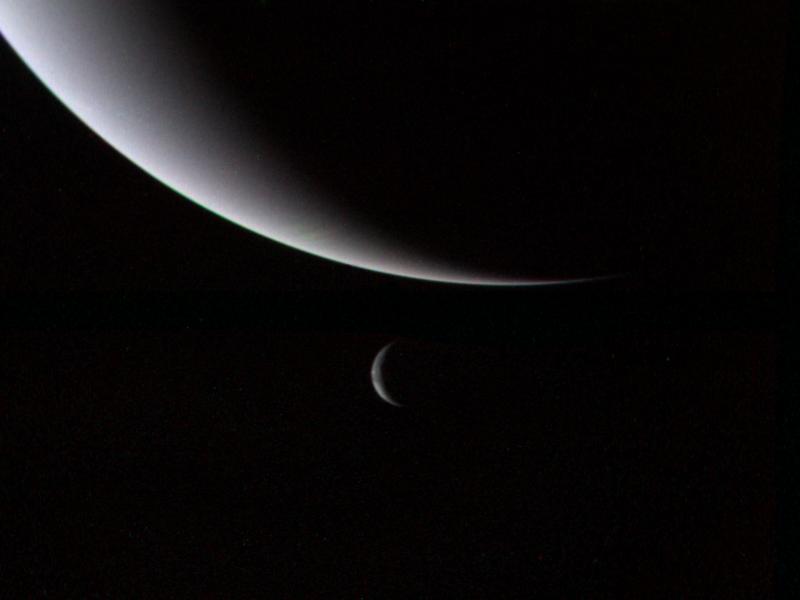
As the electrical power decreases, power loads on the spacecraft must be turned off in order to avoid having demand exceed supply. As loads are turned off, some spacecraft capabilities are eliminated.
Voyager Goals & Accomplishments
Voyager 1 and 2 were designed to take advantage of a rare planetary alignment to explore the outer solar system. Voyager 1 targeted Jupiter and Saturn before continuing on to chart the far edges of our solar system. Voyager 2 targeted Jupiter, Saturn, Uranus and Neptune before joining its sister probe on their interstellar mission.
Voyager proved to be one of the greatest missions of discovery in history. Among their many revelations about the solar system are:
- Rings around Jupiter
- Volcanoes on Jupiter's moon Io
- Moons of Saturn that shepherd its rings
- New moons around Uranus and Neptune
- Geysers of liquid nitrogen on Neptune's moon Triton
- Revealed and crossed the farthest boundary of our solar system
Voyager 2 is the only spacecraft to study all four of the solar system's giant planets at close range. The Voyagers are now exploring the outermost reaches of our sun's influence, where the solar wind mixes with the interstellar wind of our galaxy. Their long-lived power source has enabled these explorers to continue teaching us about our solar system for more than years after they left earth.
- Go to Voyager Homepage
- Go to Voyager Image Gallery
- Status: Where are the Voyagers?

Mission Elapsed Time
After months of silence, Voyager 1 has returned NASA’s calls

- Show more sharing options
- Copy Link URL Copied!
For the last five months, it seemed very possible that a 46-year-old conversation had finally reached its end.
Since its launch from Kennedy Space Center on Sept. 5, 1977, NASA’s Voyager 1 spacecraft has diligently sent regular updates to Earth on the health of its systems and data collected from its onboard instruments.
But in November, the craft went quiet.
Voyager 1 is now some 15 billion miles away from Earth. Somewhere in the cold interstellar space between our sun and the closest stars, its flight data system stopped communicating with the part of the probe that allows it to send signals back to Earth. Engineers at the Jet Propulsion Laboratory in La Cañada Flintridge could tell that Voyager 1 was getting its messages, but nothing was coming back.
“We’re to the point where the hardware is starting to age,” said Linda Spilker, the project scientist for the Voyager mission. “It’s like working on an antique car, from 15 billion miles away.”
Week after week, engineers sent troubleshooting commands to the spacecraft, each time patiently waiting the 45 hours it takes to get a response here on Earth — 22.5 hours traveling at the speed of light to reach the probe, and 22.5 hours back.

Science & Medicine
This space artist created the Golden Record and changed the way we see the universe
Space artist Jon Lomberg has produced work that attempts to visualize what we can’t truly see, and to communicate with creatures we can’t yet imagine.
July 26, 2023
By March, the team had figured out that a memory chip that stored some of the flight data system’s software code had failed, turning the craft’s outgoing communications into gibberish.
A long-distance repair wasn’t possible. There wasn’t enough space anywhere in the system to shift the code in its entirety. So after manually reviewing the code line by line, engineers broke it up and tucked the pieces into the available slots of memory.
They sent a command to Voyager on Thursday. In the early morning hours Saturday, the team gathered around a conference table at JPL: laptops open, coffee and boxes of doughnuts in reach.
At 6:41 a.m., data from the craft showed up on their screens. The fix had worked .
“We went from very quiet and just waiting patiently to cheers and high-fives and big smiles and sighs of relief,” Spilker said. “I’m very happy to once again have a meaningful conversation with Voyager 1.”
Voyager 1 is one of two identical space probes. Voyager 2, launched two weeks before Voyager 1, is now about 13 billion miles from Earth, the two crafts’ trajectories having diverged somewhere around Saturn. (Voyager 2 continued its weekly communications uninterrupted during Voyager 1’s outage.)

Space shuttle Endeavour is lifted into the sky, takes final position as star of new museum wing
A shrink-wrapped Endeavour was hoisted and then carefully placed in its final location Tuesday at the still-under-construction Samuel Oschin Air and Space Center.
Jan. 30, 2024
They are the farthest-flung human-made objects in the universe, having traveled farther from their home planet than anything else this species has built. The task of keeping communications going grows harder with each passing day. Every 24 hours, Voyager 1 travels 912,000 miles farther away from us. As that distance grows, the signal becomes slower and weaker.
When the probe visited Jupiter in 1979, it was sending back data at a rate of 115.2 kilobits per second, Spilker said. Today, 45 years and more than 14 billion miles later, data come back at a rate of 40 bits per second.
The team is cautiously optimistic that the probes will stay in contact for three more years, long enough to celebrate the mission’s 50th anniversary in 2027, Spilker said. They could conceivably last until the 2030s.
The conversation can’t last forever. Microscopic bits of silica keep clogging up the thrusters that keep the probes’ antennas pointed toward Earth, which could end communications. The power is running low. Eventually, the day will come when both Voyagers stop transmitting data to Earth, and the first part of their mission ends.
But on the day each craft goes quiet, they begin a new era, one that could potentially last far longer. Each probe is equipped with a metallic album cover containing a Golden Record , a gold-plated copper disk inscribed with sounds and images meant to describe the species that built the Voyagers and the planet they came from.
Erosion in space is negligible; the images could be readable for another billion years or more. Should any other intelligent life form encounter one of the Voyager probes and have a means of retrieving the data from the record, they will at the very least have a chance to figure out who sent them — even if our species is by that time long gone.
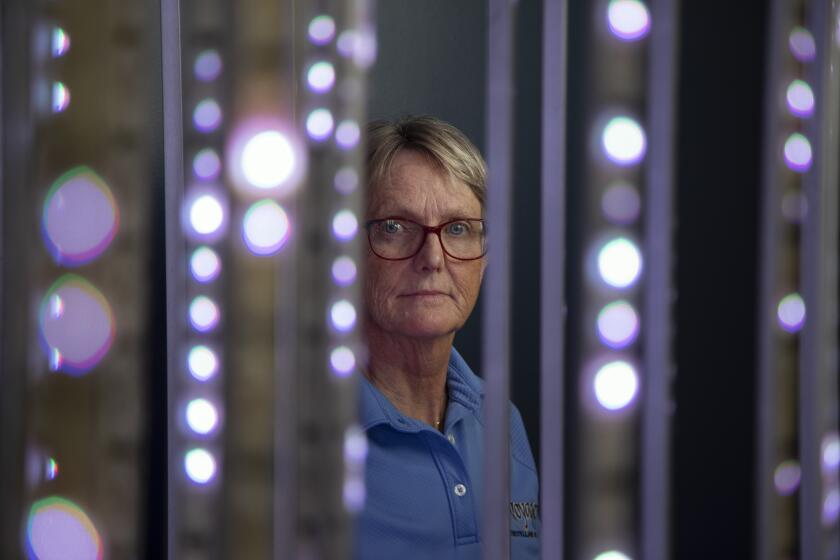
JPL tries to keep Voyager space probes from disconnecting the world’s longest phone call
Keeping in touch with NASA’s two aging Voyager spacecraft is getting harder to do as they get farther away and their power sources dwindle.
Sept. 3, 2022
More to Read

Too expensive, too slow: NASA asks for help with JPL’s Mars Sample Return mission
April 15, 2024

NASA’s attempt to bring home part of Mars is unprecedented. The mission’s problems are not
March 25, 2024
Budget deal for NASA offers glimmer of hope for JPL’s Mars Sample Return mission
March 6, 2024

Corinne Purtill is a science and medicine reporter for the Los Angeles Times. Her writing on science and human behavior has appeared in the New Yorker, the New York Times, Time Magazine, the BBC, Quartz and elsewhere. Before joining The Times, she worked as the senior London correspondent for GlobalPost (now PRI) and as a reporter and assignment editor at the Cambodia Daily in Phnom Penh. She is a native of Southern California and a graduate of Stanford University.
More From the Los Angeles Times

LAPD detective charged with hit-and-run after off-duty crash on 5 Freeway
May 3, 2024

Mill Valley teacher suspected of sexual abuse is found dead near Drakes Beach

He drove his family off a cliff in a Tesla. Now his wife wants him freed

Patrick Beverley hits fan in stands with ball, kicks ESPN journalist out of interview
Voyager 1: Facts about Earth's farthest spacecraft
Voyager 1 continues to explore the cosmos along with its twin probe, Voyager 2.
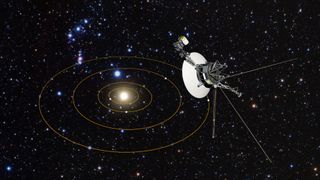
The Grand Tour
Voyager 1 jupiter flyby, voyager 1 visits saturn and its moons, voyager 1 enters interstellar space, voyager 1's interstellar adventures, additional resources.
Voyager 1 is the first spacecraft to travel beyond the solar system and reach interstellar space .
The probe launched on Sept. 5, 1977 — about two weeks after its twin Voyager 2 — and as of August 2022 is approximately 14.6 billion miles (23.5 billion kilometers) away from our planet, making it Earth 's farthest spacecraft. Voyager 1 is currently zipping through space at around 38,000 mph (17 kilometers per second), according to NASA Jet Propulsion Laboratory .
When Voyager 1 launched a mission to explore the outer planets in our solar system nobody knew how important the probe would still be 45 years later The probe has remained operational long past expectations and continues to send information about its journeys back to Earth.
Related: Celebrate 45 years of Voyager with these amazing images of our solar system (gallery)

Elizabeth Howell, Ph.D., is a staff writer in the spaceflight channel since 2022. She was contributing writer for Space.com for 10 years before that, since 2012. Elizabeth's on-site reporting includes two human spaceflight launches from Kazakhstan, three space shuttle missions in Florida, and embedded reporting from a simulated Mars mission in Utah.
Size: Voyager 1's body is about the size of a subcompact car. The boom for its magnetometer instrument extends 42.7 feet (13 meters). Weight (at launch): 1,797 pounds (815 kilograms). Launch date: Sept. 5, 1977
Jupiter flyby date: March 5, 1979
Saturn flyby date: Nov. 12, 1980.
Entered interstellar space: Aug. 25, 2012.
The spacecraft entered interstellar space in August 2012, almost 35 years after its voyage began. The discovery wasn't made official until 2013, however, when scientists had time to review the data sent back from Voyager 1.
Voyager 1 was the second of the twin spacecraft to launch, but it was the first to race by Jupiter and Saturn . The images Voyager 1 sent back have been used in schoolbooks and by many media outlets for a generation. The spacecraft also carries a special record — The Golden Record — that's designed to carry voices and music from Earth out into the cosmos.
According to NASA Jet Propulsion Laboratory (JPL) , Voyager 1 has enough fuel to keep its instruments running until at least 2025. By then, the spacecraft will be approximately 13.8 billion miles (22.1 billion kilometers) away from the sun.
The Voyager missions took advantage of a special alignment of the outer planets that happens just once every 176 years. This alignment allows spacecraft to gravitationally "slingshot" from one planet to the next, making the most efficient use of their limited fuel.
NASA originally planned to send two spacecraft past Jupiter, Saturn and Pluto and two other probes past Jupiter, Uranus and Neptune . Budgetary reasons forced the agency to scale back its plans, but NASA still got a lot out of the two Voyagers it launched.
Voyager 2 flew past Jupiter, Saturn, Uranus and Neptune , while Voyager 1 focused on Jupiter and Saturn.
Recognizing that the Voyagers would eventually fly to interstellar space, NASA authorized the production of two Golden Records to be placed on board the spacecraft. Sounds ranging from whale calls to the music of Chuck Berry were placed on board, as well as spoken greetings in 55 languages.
The 12-inch-wide (30 centimeters), gold-plated copper disks also included pictorials showing how to operate them and the position of the sun among nearby pulsars (a type of fast-spinning stellar corpse known as a neutron star ), in case extraterrestrials someday stumbled onto the spacecraft and wondered where they came from.
Both spacecraft are powered by three radioisotope thermoelectric generators , devices that convert the heat released by the radioactive decay of plutonium to electricity. Both probes were outfitted with 10 scientific instruments, including a two-camera imaging system, multiple spectrometers, a magnetometer and gear that detects low-energy charged particles and high-energy cosmic rays . Mission team members have also used the Voyagers' communications system to help them study planets and moons, bringing the total number of scientific investigations on each craft to 11.
Voyager 1 almost didn't get off the ground at its launch , as its rocket came within 3.5 seconds of running out of fuel on Sept. 5, 1977.
But the probe made it safely to space and raced past its twin after launch, getting beyond the main asteroid belt between Mars and Jupiter before Voyager 2 did. Voyager 1's first pictures of Jupiter beamed back to Earth in April 1978, when the probe was 165 million miles (266 million kilometers) from home.
According to NASA , each voyager probe has about 3 million times less memory than a mobile phone and transmits data approximately 38,000 times slower than a 5g internet connection.
To NASA's surprise, in March 1979 Voyager 1 spotted a thin ring circling the giant planet. It found two new moons as well — Thebe and Metis. Additionally, Voyager 1 sent back detailed pictures of Jupiter's big Galilean moons ( Io , Europa , Ganymede and Callisto ) as well as Amalthea .
Like the Pioneer spacecraft before it , Voyager's look at Jupiter's moons revealed them to be active worlds of their own. And Voyager 1 made some intriguing discoveries about these natural satellites. For example, Io's many volcanoes and mottled yellow-brown-orange surface showed that, like planets, moons can have active interiors.
Additionally, Voyager 1 sent back photos of Europa showing a relatively smooth surface broken up by lines, hinting at ice and maybe even an ocean underneath. (Subsequent observations and analyses have revealed that Europa likely harbors a huge subsurface ocean of liquid water, which may even be able to support Earth-like life .)
Voyager 1's closest approach to Jupiter was on March 5, 1979, when it came within 174,000 miles (280,000 km) of the turbulent cloud tops. Then it was time for the probe to aim for Saturn.
Scientists only had to wait about a year, until 1980, to get close-up pictures of Saturn. Like Jupiter, the ringed planet turned out to be full of surprises.
One of Voyager 1's targets was the F ring, a thin structure discovered only the year previously by NASA's Pioneer 11 probe. Voyager's higher-resolution camera spotted two new moons, Prometheus and Pandora, whose orbits keep the icy material in the F ring in a defined orbit. It also discovered Atlas and a new ring, the G ring, and took images of several other Saturn moons.
One puzzle for astronomers was Titan , the second-largest moon in the solar system (after Jupiter's Ganymede). Close-up pictures of Titan showed nothing but orange haze, leading to years of speculation about what it was like underneath. It wouldn't be until the mid-2000s that humanity would find out, thanks to photos snapped from beneath the haze by the European Space Agency's Huygens atmospheric probe .
The Saturn encounter marked the end of Voyager 1's primary mission. The focus then shifted to tracking the 1,590-pound (720 kg) craft as it sped toward interstellar space.
Two decades before it notched that milestone, however, Voyager 1 took one of the most iconic photos in spaceflight history. On Feb. 14, 1990, the probe turned back toward Earth and snapped an image of its home planet from 3.7 billion miles (6 billion km) away. The photo shows Earth as a tiny dot suspended in a ray of sunlight.
Voyager 1 took dozens of other photos that day, capturing five other planets and the sun in a multi-image "solar system family portrait." But the Pale Blue Dot picture stands out, reminding us that Earth is a small outpost of life in an incomprehensibly vast universe.
Voyager 1 left the heliosphere — the giant bubble of charged particles that the sun blows around itself — in August 2012, popping free into interstellar space. The discovery was made public in a study published in the journal Science the following year.
The results came to light after a powerful solar eruption was recorded by Voyager 1's plasma wave instrument between April 9 and May 22, 2013. The eruption caused electrons near Voyager 1 to vibrate. From the oscillations, researchers discovered that Voyager 1's surroundings had a higher density than what is found just inside the heliosphere.
It seems contradictory that electron density is higher in interstellar space than it is in the sun's neighborhood. But researchers explained that, at the edge of the heliosphere, the electron density is dramatically low compared with locations near Earth.
Researchers then backtracked through Voyager 1's data and nailed down the official departure date to Aug. 25, 2012. The date was fixed not only by the electron oscillations but also by the spacecraft's measurements of charged solar particles.
On that fateful day — which was the same day that Apollo 11 astronaut Neil Armstrong died — the probe saw a 1,000-fold drop in these particles and a 9% increase in galactic cosmic rays that come from outside the solar system . At that point, Voyager 1 was 11.25 billion miles (18.11 billion km) from the sun, or about 121 astronomical units (AU).
One AU is the average Earth-sun distance — about 93 million miles (150 million km).
You can keep tabs on the Voyager 1's current distance and mission status on this NASA website .
Since flying into interstellar space, Voyager 1 has sent back a variety of valuable information about conditions in this zone of the universe . Its discoveries include showing that cosmic radiation out there is very intense, and demonstrating how charged particles from the sun interact with those emitted by other stars , mission project scientist Ed Stone, of the California Institute of Technology in Pasadena, told Space.com in September 2017 .
The spacecraft's capabilities continue to astound engineers. In December 2017, for example, NASA announced that Voyager 1 successfully used its backup thrusters to orient itself to "talk" with Earth . The trajectory correction maneuver (TCM) thrusters hadn't been used since November 1980, during Voyager 1's flyby of Saturn. Since then, the spacecraft had primarily used its standard attitude-control thrusters to swing the spacecraft in the right orientation to communicate with Earth.
As the performance of the attitude-control thrusters began to deteriorate, however, NASA decided to test the TCM thrusters — an idea that could extend Voyager 1's operational life. That test ultimately succeeded.
"With these thrusters that are still functional after 37 years without use, we will be able to extend the life of the Voyager 1 spacecraft by two to three years," Voyager project manager Suzanne Dodd, of NASA's Jet Propulsion, Laboratory (JPL) in Southern California, said in a statement in December 2017 .
Mission team members have taken other measures to extend Voyager 1's life as well. For example, they turned off the spacecraft's cameras shortly after the Pale Blue Dot photo was taken to help conserve Voyager 1's limited power supply. (The cameras wouldn't pick up much in the darkness of deep space anyway.) Over the years, the mission team has turned off five other scientific instruments as well, leaving Voyager 1 with four that are still functioning — the Cosmic Ray Subsystem, the Low-Energy Charged Particles instrument, the Magnetometer and the Plasma Wave Subsystem. (Similar measures have been taken with Voyager 2, which currently has five operational instruments .)
The Voyager spacecraft each celebrated 45 years in space in 2022, a monumental milestone for the twin probes.
"Over the last 45 years, the Voyager missions have been integral in providing this knowledge and have helped change our understanding of the sun and its influence in ways no other spacecraft can," says Nicola Fox, director of the Heliophysics Division at NASA Headquarters in Washington, in a NASA statement .
"Today, as both Voyagers explore interstellar space, they are providing humanity with observations of uncharted territory," said Linda Spilker, Voyager's deputy project scientist at JPL in the same NASA statement.
"This is the first time we've been able to directly study how a star, our Sun, interacts with the particles and magnetic fields outside our heliosphere, helping scientists understand the local neighborhood between the stars, upending some of the theories about this region, and providing key information for future missions." Spilker continues.
Voyager 1's next big encounter will take place in 40,000 years when the probe comes within 1.7 light-years of the star AC +79 3888. (The star is roughly 17.5 light-years from Earth.) However, Voyager 1's falling power supply means it will probably stop collecting scientific data around 2025.
You can learn much more about both Voyagers' design, scientific instruments and mission goals at JPL's Voyager site . NASA has lots of in-depth information about the Pale Blue Dot photo, including Carl Sagan's large role in making it happen, here . And if you're interested in the Golden Record, check out this detailed New Yorker piece by Timothy Ferris, who produced the historic artifact. Explore the history of Voyager with this interactive timeline courtesy of NASA.
Bibliography
- Bell, Jim. " The Interstellar Age: Inside the Forty-Year Voyager Mission ," Dutton, 2015.
- Landau, Elizabeth. "The Voyagers in popular culture," Dec. 1, 2017. https://www.nasa.gov/feature/jpl/the-voyagers-in-popular-culture
- PBS, "Voyager: A history in photos." https://www.pbs.org/the-farthest/mission/voyager-history-photos/
Join our Space Forums to keep talking space on the latest missions, night sky and more! And if you have a news tip, correction or comment, let us know at: [email protected].
Get the Space.com Newsletter
Breaking space news, the latest updates on rocket launches, skywatching events and more!

Elizabeth Howell (she/her), Ph.D., is a staff writer in the spaceflight channel since 2022 covering diversity, education and gaming as well. She was contributing writer for Space.com for 10 years before joining full-time. Elizabeth's reporting includes multiple exclusives with the White House and Office of the Vice-President of the United States, an exclusive conversation with aspiring space tourist (and NSYNC bassist) Lance Bass, speaking several times with the International Space Station, witnessing five human spaceflight launches on two continents, flying parabolic, working inside a spacesuit, and participating in a simulated Mars mission. Her latest book, " Why Am I Taller ?", is co-written with astronaut Dave Williams. Elizabeth holds a Ph.D. and M.Sc. in Space Studies from the University of North Dakota, a Bachelor of Journalism from Canada's Carleton University and a Bachelor of History from Canada's Athabasca University. Elizabeth is also a post-secondary instructor in communications and science at several institutions since 2015; her experience includes developing and teaching an astronomy course at Canada's Algonquin College (with Indigenous content as well) to more than 1,000 students since 2020. Elizabeth first got interested in space after watching the movie Apollo 13 in 1996, and still wants to be an astronaut someday. Mastodon: https://qoto.org/@howellspace
- Daisy Dobrijevic Reference Editor
SpaceX to launch 23 Starlink satellites tonight in 2nd half of spaceflight doubleheader
SpaceX Falcon 9 rocket launches 2 satellites on record-tying 20th flight (video)
Curious asteroid Selam, spotted by NASA's Lucy spacecraft, is a cosmic toddler
Most Popular
- 2 Astronauts on the moon could stay fit by running in a Wheel of Death
- 3 Watch live: China launching Chang'e 6 mission to far side of the moon early May 3 (video)
- 4 Watch ULA assemble Atlas V rocket ahead of Boeing Starliner astronaut test flight (video)
- 5 NASA's Hubble Telescope is back in action — but its TESS exoplanet hunter may now be in trouble
- Ask An Astrobiologist
- Resources Graphic Histories Coloring Pages Heroes Posters Life in the extremes Digital Backgrounds SciComm Guild

Voyager 1 and Voyager 2
Voyager interstellar mission.
- Launch Date August 19, 1977
- Arrival Date April 08, 1979
- Mission Type Outer Solar System
- Target Outer Solar System
Mission Overview
The primary mission of the Voyager 1 and Voyager 2 spacecraft was to explore the outer planets of Jupiter and Saturn. Voyager 2 launched on August 20, 1977, from Cape Canaveral, Florida aboard a Titan-Centaur rocket. On September 5, Voyager 1 launched, also from Cape Canaveral aboard a Titan-Centaur rocket. The Voyager Interstellar Mission was the first to provide humankind with a close-up view of the outer planets. Between them, Voyager 1 and 2 explored all the giant planets of our outer solar system, Jupiter, Saturn, Uranus and Neptune; 48 of their moons; and the unique system of rings and magnetic fields those planets possess.
Relevance to Astrobiology
The twin Voyager 1 and 2 spacecraft are now exploring reaches of space where nothing from Earth has flown before. The twin spacecraft are continuing on their more-than-37-year journey that began with their respective launches in 1977. Each spacecraft is now traveling further from the Earth and the Sun than Pluto.
After making a string of discoveries there — such as active volcanoes on Jupiter’s moon Io and intricacies of Saturn’s rings — the mission was extended. Voyager 2 went on to explore Uranus and Neptune, and is still the only spacecraft to have visited those outer planets. The adventurers’ current mission, the Voyager Interstellar Mission ( VIM ), will explore the outermost edge of the Sun’s domain. And beyond.
NASA Astrobiology Involvement
The Voyager mission has dramatically shaped our understanding of the Solar System and the potential for life on our system’s planets and moons. It was data from Voyager that first raised questions about the potential for liquid water beneath the icy crust of Jupiter’s moon Europa. Voyager also revealed that Saturn’s moon Titan was shrouded in a thick atmospheric haze, a finding that ultimately led to the development of the Cassini-Huygens mission. Astrobiologists today still use data from Voyager, revealing more and more clues about the worlds that circle the Sun beyond the Asteroid Belt.

Observations from the twin Voyager spacecraft suggested that an ocean might exist beneath the cracked icy crust of Jupiter’s moon Europa.
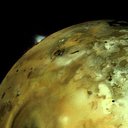
Voyager discovered that Jupiter’s moon Io was active. The spacecraft spotted erupting volcanoes on Io’s surface, making it 100 times the volcanic activity of Earth. Voyager also discovered the Io torus, a thick ring of ionized sulfur and oxygen shed by Io that inflates Jupiter’s giant magnetic field

Voyager found Saturn’s moon Titan shrouded in a deep, smoggy nitrogen atmosphere. Titan was a high priority for the Voyager flybys at Saturn. The two spacecraft saw tantalizing hints of the structure and composition of the giant moon’s dense atmosphere. This Voyager 2 photograph of Titan, taken Aug. 23, 1981 from a range of 2.3 million kilometers (1.4 million miles), shows some detail in the cloud systems on this Saturnian moon.

The closest approach to Jupiter occurred on March 5, 1979 for Voyager 1; July 9, 1979 for Voyager 2. Voyager 1 took this photo of Jupiter and two of its satellites (Io, left, and Europa) on Feb. 13, 1979.
The closest approach to Saturn occurred on November 12, 1980 for Voyager 1; August 25, 1981 for Voyager 2. Voyager 1 captured this image of Saturn on Nov. 16, 1980.
The closest approach to Uranus occurred on January 24, 1986 by Voyager 2. The spacecraft observed a bluish orb with extremely subtle features. A haze layer hid most of the planet’s cloud features from view.
The closest approach to Neptune occurred on August 25, 1989 by Voyager 2. This contrast-enhanced image of Neptune was taken 11 days before that encounter.
As of September 2013, Voyager 2 was at a distance of 15.3 billion kilometers (102.6 AU) from the Sun.
Voyager 2 is escaping the Solar System at a speed of about 3.3 AU per year.
A total of 11,000 work years was devoted to the Voyager project through the Neptune encounter. This is equivalent to one-third the amount of effort estimated to complete the great pyramid at Giza to King Cheops.
The Voyager spacecraft appear in Issue #4 of the Astrobiology Graphic History: https://astrobiology.nasa.gov/resources/graphic-histories/
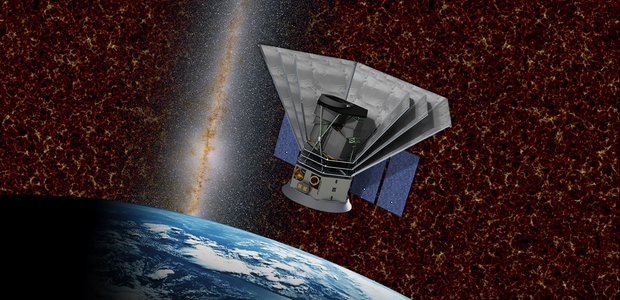

- A Star is Born
- How Planets Form
- What Are They, and Where Are They?
- Atmospheres
- Magnetospheres
- What's the Deal With Moons?
- The Galilean Moons of Jupiter
- Moons of Saturn, Uranus, & Neptune
- Dwarf Planets
- Dust and Plasma
- ◊Extrasolar Planets
- Pioneer 10 & 11
- Voyager 1 & 2
- New Frontiers
- ◊Lessons and Activities

Voyager 1 & 2 Voyager 1 & 2
- Launch Date: 5 September 1977
- Mission: Explore Jupiter, Saturn and their satellites
- Arrived at Jupiter: March 1979
- Arrived at Saturn: November 1980
Launched from Kennedy Space Center, Voyager 1 was the first of twin spacecrafts launched in 1977 to reach Jupiter. Voyager 1 set out to collect information on the atmospheres, interiors, satellites and magnetospheres of Jupiter and Saturn. Voyager 1 took roughly 32,000 pictures of Jupiter, Saturn and their moons and rings. When its mission was complete, Voyager 1 remained rather quiet until its cameras were turned back on in early 1990 to take pictures of our solar system. Voyager 1 took some 60 pictures of the Sun and 6 of the planets, the first shots ever taken from "outside" our Solar System. The 60 frames were combined to make the mosaic seen below. The six individual shots on the right were taken when Voyager 1 was more than 4 billion miles from Earth. Earth appears framed in brightness due to the amount of light scattered while taking the picture with Earth so close to the Sun.

FIND OUT MORE AT THE VOYAGER HOME PAGE Capturing shots of the Sun, Venus, Earth, Jupiter, Saturn, Uranus and Neptune was the last of Voyager's tasks and the cameras were once again turned off. Still speeding away from us, Voyager 1 is approaching the outer edge of our Solar System and is currently the most distant man-made object in space.
- Launch Date: 20 August 1977
- Mission: Explore all of the outer planets and their satellites
- Arrived at Jupiter: July 1979
- Arrived at Saturn: August 1981
- Arrived at Uranus: January 1986
- Arrived at Neptune: August 1989
Even though it arrived at Jupiter 4 months later, Voyager 2 actually left Earth before Voyager 1. Voyager 2's objectives were the same as Voyager 1, and they both ended up collecting about the same number of photographs of Jupiter and Saturn. Despite initial complications with Voyager 2, permission was granted to extend its mission to Uranus, Neptune and beyond.
Successful flybys of Uranus starting in January 1986 allowed for roughly 8,000 images of the planet and its satellites. A few years later, in August 1989, Voyager 2 arrived at Neptune and collected around 10,000 images.

This image of Neptune, taken by Voyager 2, shows the Great Dark Spot. Though comparable in size to the Great Red Spot on Jupiter, it is actually an atmospheric hole kind of like the one in the Earth's ozone layer. The picture below is a close up of the Great Dark Spot, also taken by Voyager 2.

Results of the Voyager missions
- Discovery of 22 new satellites: 3 at Jupiter, 3 at Saturn, 10 at Uranus, 6 at Neptune
- Discovery of Jupiter's rings, and additional information about the rings of Saturn, Uranus and Neptune
- Discovery of Uranian and Neptunian magnetospheres
- Discovery of active volcanism on Io, and active geyser-like structures on Triton
- Discovery of auroral zones on Jupiter, Saturn and Neptune

- Work & Careers
- Life & Arts
Become an FT subscriber
Try unlimited access Only $1 for 4 weeks
Then $75 per month. Complete digital access to quality FT journalism on any device. Cancel anytime during your trial.
- Global news & analysis
- Expert opinion
- Special features
- FirstFT newsletter
- Videos & Podcasts
- Android & iOS app
- FT Edit app
- 10 gift articles per month
Explore more offers.
Standard digital.
- FT Digital Edition
Premium Digital
Print + premium digital, weekend print + standard digital, weekend print + premium digital.
Today's FT newspaper for easy reading on any device. This does not include ft.com or FT App access.
- Global news & analysis
- Exclusive FT analysis
- FT App on Android & iOS
- FirstFT: the day's biggest stories
- 20+ curated newsletters
- Follow topics & set alerts with myFT
- FT Videos & Podcasts
- 20 monthly gift articles to share
- Lex: FT's flagship investment column
- 15+ Premium newsletters by leading experts
- FT Digital Edition: our digitised print edition
- Weekday Print Edition
- Videos & Podcasts
- Premium newsletters
- 10 additional gift articles per month
- FT Weekend Print delivery
- Everything in Standard Digital
- Everything in Premium Digital
Essential digital access to quality FT journalism on any device. Pay a year upfront and save 20%.
- 10 monthly gift articles to share
- Everything in Print
Complete digital access to quality FT journalism with expert analysis from industry leaders. Pay a year upfront and save 20%.
Terms & Conditions apply
Explore our full range of subscriptions.
Why the ft.
See why over a million readers pay to read the Financial Times.
International Edition

First to visit all four giant planets

Voyager 2 is the only spacecraft to visit Uranus and Neptune. The probe is now in interstellar space, the region outside the heliopause, or the bubble of energetic particles and magnetic fields from the Sun.
Mission Type
What is Voyager 2?
NASA's Voyager 2 is the second spacecraft to enter interstellar space. On Dec. 10, 2018, the spacecraft joined its twin – Voyager 1 – as the only human-made objects to enter the space between the stars.
- Voyager 2 is the only spacecraft to study all four of the solar system's giant planets at close range.
- Voyager 2 discovered a 14th moon at Jupiter.
- Voyager 2 was the first human-made object to fly past Uranus.
- At Uranus, Voyager 2 discovered 10 new moons and two new rings.
- Voyager 2 was the first human-made object to fly by Neptune.
- At Neptune, Voyager 2 discovered five moons, four rings, and a "Great Dark Spot."
In Depth: Voyager 2
The two-spacecraft Voyager missions were designed to replace original plans for a “Grand Tour” of the planets that would have used four highly complex spacecraft to explore the five outer planets during the late 1970s.
NASA canceled the plan in January 1972 largely due to anticipated costs (projected at $1 billion) and instead proposed to launch only two spacecraft in 1977 to Jupiter and Saturn. The two spacecraft were designed to explore the two gas giants in more detail than the two Pioneers (Pioneers 10 and 11) that preceded them.
In 1974, mission planners proposed a mission in which, if the first Voyager was successful, the second one could be redirected to Uranus and then Neptune using gravity assist maneuvers.
Each of the two spacecraft was equipped with a slow-scan color TV camera to take images of the planets and their moons and each also carried an extensive suite of instruments to record magnetic, atmospheric, lunar, and other data about the planetary systems.
The design of the two spacecraft was based on the older Mariners, and they were known as Mariner 11 and Mariner 12 until March 7, 1977, when NASA Administrator James C. Fletcher (1919-1991) announced that they would be renamed Voyager.
Power was provided by three plutonium oxide radioisotope thermoelectric generators (RTGs) mounted at the end of a boom.
Voyager 2 at Jupiter
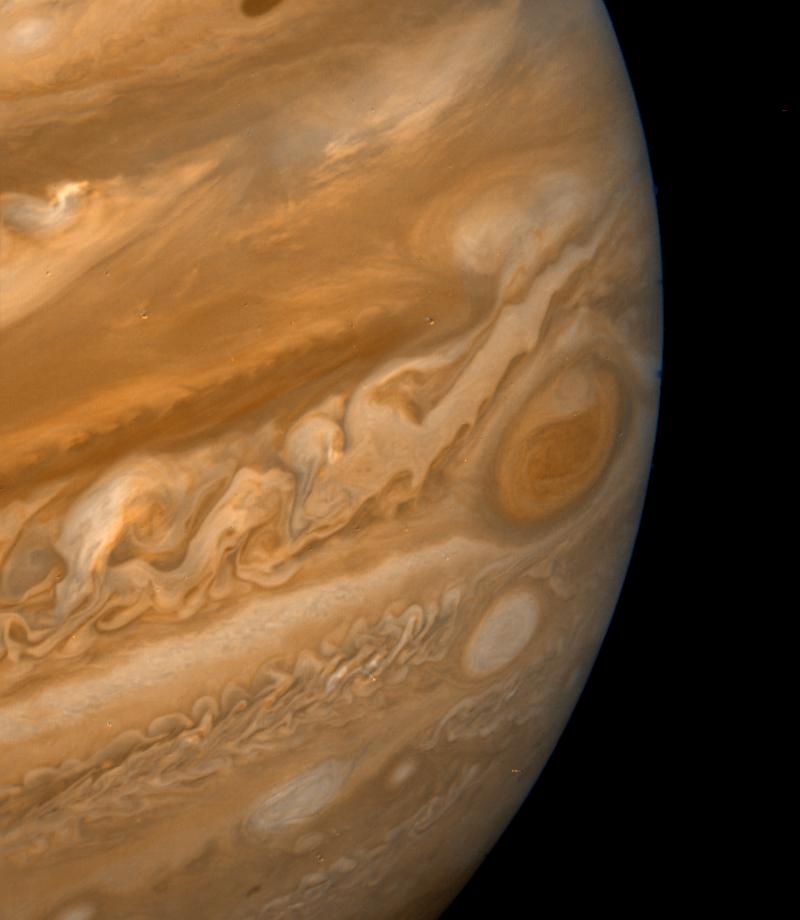
Voyager 2 began transmitting images of Jupiter April 24, 1979, for time-lapse movies of atmospheric circulation. Unlike Voyager 1, Voyager 2 made close passes to the Jovian moons on its way into the system, with scientists especially interested in more information from Europa and Io (which necessitated a 10 hour-long “volcano watch”).
During its encounter, it relayed back spectacular photos of the entire Jovian system, including its moons Callisto, Ganymede, Europa (at a range of about 127,830 miles or 205,720 kilometers, much closer than Voyager 1), Io, and Amalthea, all of which had already been surveyed by Voyager 1.
Voyager 2’s closest encounter to Jupiter was at 22:29 UT July 9, 1979, at a range of about 400,785 miles (645,000 kilometers). It transmitted new data on the planet’s clouds, its newly discovered four moons, and ring system as well as 17,000 new pictures.
When the earlier Pioneers flew by Jupiter, they detected few atmospheric changes from one encounter to the second, but Voyager 2 detected many significant changes, including a drift in the Great Red Spot as well as changes in its shape and color.
With the combined cameras of the two Voyagers, at least 80% of the surfaces of Ganymede and Callisto were mapped out to a resolution of about 3 miles (5 kilometers).
Voyager 2 at Saturn
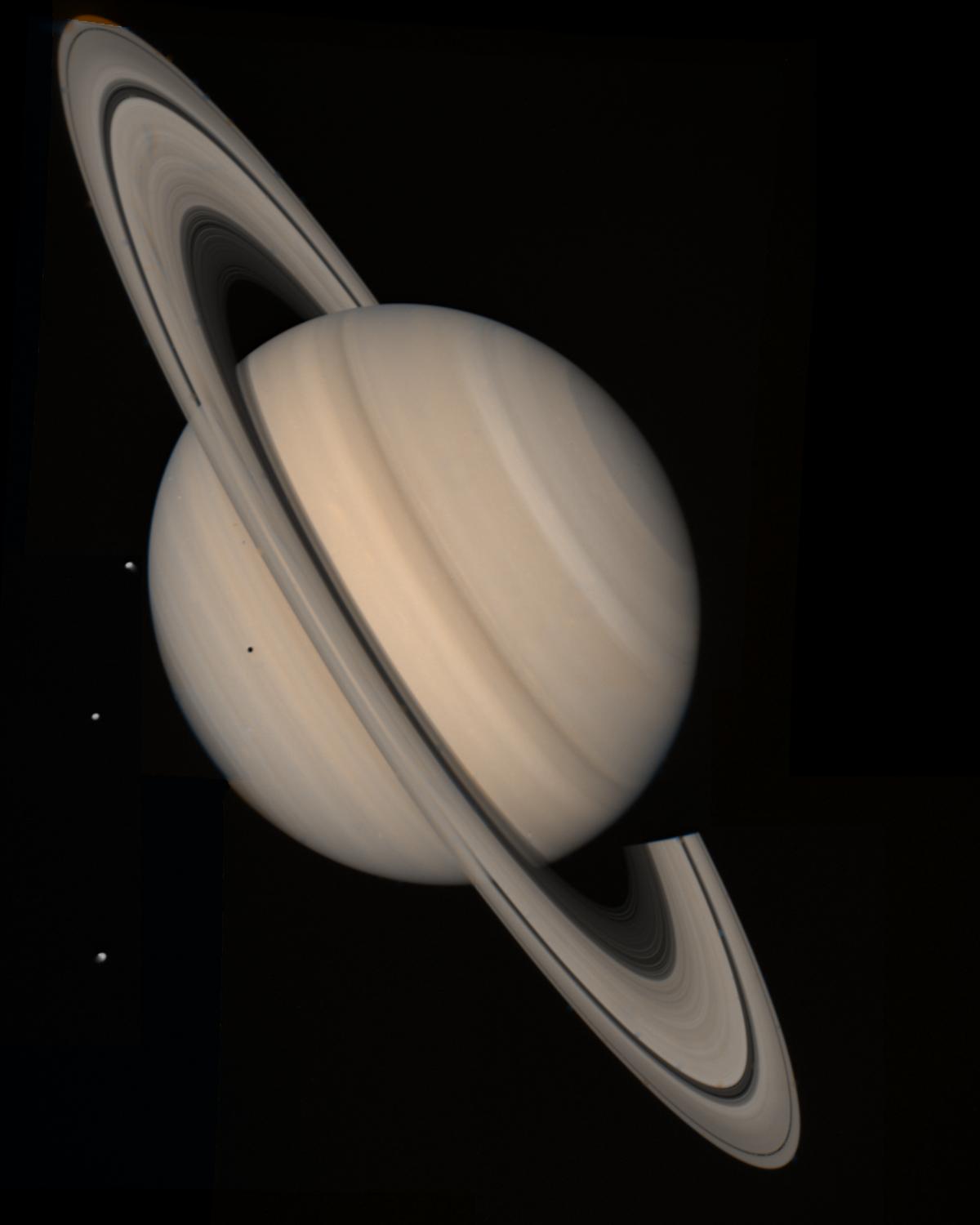
Following a course correction two hours after its closest approach to Jupiter, Voyager 2 sped to Saturn, its trajectory determined to a large degree by a decision made in January 1981, to try to send the spacecraft to Uranus and Neptune later in the decade.
Its encounter with the sixth planet began Aug. 22, 1981, two years after leaving the Jovian system, with imaging of the moon Iapetus. Once again, Voyager 2 repeated the photographic mission of its predecessor, although it actually flew about 14,290 miles (23,000 kilometers) closer to Saturn. The closest encounter to Saturn was at 01:21 UT Aug. 26, 1981, at a range of about 63,000 miles (101,000 kilometers).
The spacecraft provided more detailed images of the ring “spokes” and kinks, and also the F-ring and its shepherding moons, all found by Voyager 1. Voyager 2’s data suggested that Saturn’s A-ring was perhaps only about 980 feet (300 meters) thick.
As it flew behind and up past Saturn, the probe passed through the plane of Saturn’s rings at a speed of 8 miles per second (13 kilometers per second). For several minutes during this phase, the spacecraft was hit by thousands of micron-sized dust grains that created “puff” plasma as they were vaporized. Because the vehicle’s attitude was repeatedly shifted by the particles, attitude control jets automatically fired many times to stabilize the vehicle.
During the encounter, Voyager 2 also photographed the Saturn moons Hyperion (the “hamburger moon”), Enceladus, Tethys, and Phoebe as well as the more recently discovered Helene, Telesto and Calypso.
Voyager 2 at Uranus
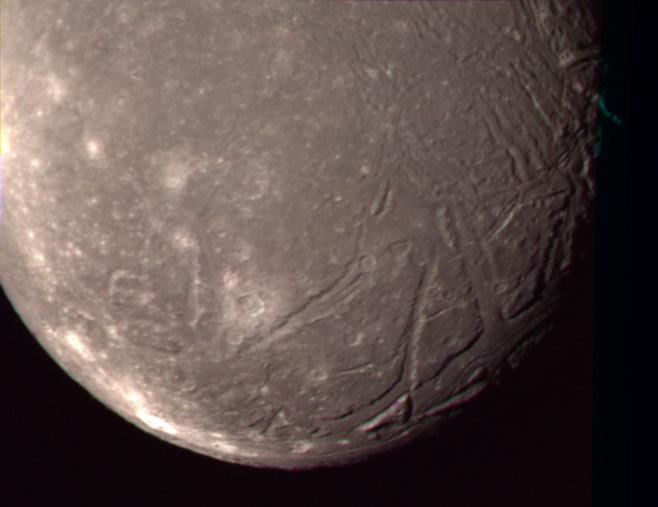
Although Voyager 2 had fulfilled its primary mission goals with the two planetary encounters, mission planners directed the veteran spacecraft to Uranus—a journey that would take about 4.5 years.
In fact, its encounter with Jupiter was optimized in part to ensure that future planetary flybys would be possible.
The Uranus encounter’s geometry was also defined by the possibility of a future encounter with Neptune: Voyager 2 had only 5.5 hours of close study during its flyby.
Voyager 2 was the first human-made object to fly past the planet Uranus.
Long-range observations of the planet began Nov. 4, 1985, when signals took approximately 2.5 hours to reach Earth. Light conditions were 400 times less than terrestrial conditions. Closest approach to Uranus took place at 17:59 UT Jan. 24, 1986, at a range of about 50,640 miles (81,500 kilometers).
During its flyby, Voyager 2 discovered 10 new moons (given such names as Puck, Portia, Juliet, Cressida, Rosalind, Belinda, Desdemona, Cordelia, Ophelia, and Bianca -- obvious allusions to Shakespeare), two new rings in addition to the “older” nine rings, and a magnetic field tilted at 55 degrees off-axis and off-center.
The spacecraft found wind speeds in Uranus’ atmosphere as high as 450 miles per hour (724 kilometers per hour) and found evidence of a boiling ocean of water some 497 miles (800 kilometers) below the top cloud surface. Its rings were found to be extremely variable in thickness and opacity.
Voyager 2 also returned spectacular photos of Miranda, Oberon, Ariel, Umbriel, and Titania, five of Uranus’ larger moons. In flying by Miranda at a range of only 17,560 miles (28,260 kilometers), the spacecraft came closest to any object so far in its nearly decade-long travels. Images of the moon showed a strange object whose surface was a mishmash of peculiar features that seemed to have no rhyme or reason. Uranus itself appeared generally featureless.
The spectacular news of the Uranus encounter was interrupted the same week by the tragic Challenger accident that killed seven astronauts during their space shuttle launch Jan. 28, 1986.
Voyager 2 at Neptune
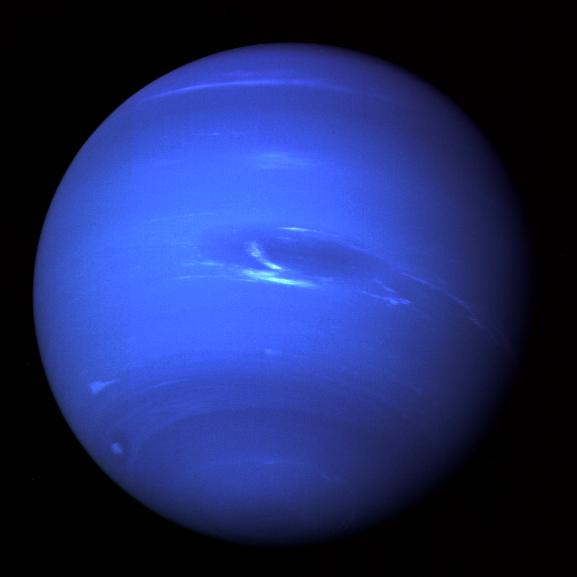
Following the Uranus encounter, the spacecraft performed a single midcourse correction Feb. 14, 1986—the largest ever made by Voyager 2—to set it on a precise course to Neptune.
Voyager 2’s encounter with Neptune capped a 4.3 billion-mile (7 billion-kilometer) journey when, on Aug. 25, 1989, at 03:56 UT, it flew about 2,980 miles (4,800 kilometers) over the cloud tops of the giant planet, the closest of its four flybys. It was the first human-made object to fly by the planet. Its 10 instruments were still in working order at the time.
During the encounter, the spacecraft discovered six new moons (Proteus, Larissa, Despina, Galatea, Thalassa, and Naiad) and four new rings.
The planet itself was found to be more active than previously believed, with 680-mile (1,100-kilometer) per hour winds. Hydrogen was found to be the most common atmospheric element, although the abundant methane gave the planet its blue appearance.
Images revealed details of the three major features in the planetary clouds—the Lesser Dark Spot, the Great Dark Spot, and Scooter.
Voyager photographed two-thirds of Neptune’s largest moon Triton, revealing the coldest known planetary body in the solar system and a nitrogen ice “volcano” on its surface. Spectacular images of its southern hemisphere showed a strange, pitted cantaloupe-type terrain.
The flyby of Neptune concluded Voyager 2’s planetary encounters, which spanned an amazing 12 years in deep space, virtually accomplishing the originally planned “Grand Tour” of the solar system, at least in terms of targets reached if not in science accomplished.
Voyager 2's Interstellar Mission
Once past the Neptune system, Voyager 2 followed a course below the ecliptic plane and out of the solar system. Approximately 35 million miles (56 million kilometers) past the encounter, Voyager 2’s instruments were put in low power mode to conserve energy.
After the Neptune encounter, NASA formally renamed the entire project the Voyager Interstellar Mission (VIM).
Of the four spacecraft sent out to beyond the environs of the solar system in the 1970s, three of them -- Voyagers 1 and 2 and Pioneer 11 -- were all heading in the direction of the solar apex, i.e., the apparent direction of the Sun’s travel in the Milky Way galaxy, and thus would be expected to reach the heliopause earlier than Pioneer 10 which was headed in the direction of the heliospheric tail.
In November 1998, 21 years after launch, nonessential instruments were permanently turned off, leaving seven instruments still operating.
At 9.6 miles per second (15.4 kilometers per second) relative to the Sun, it will take about 19,390 years for Voyager 2 to traverse a single light year.

Asif Siddiqi
Beyond Earth: A Chronicle of Deep Space Exploration
Through the turn of the century, NASA's Jet Propulsion Laboratory (JPL) continued to receive ultraviolet and particle fields data. For example, on Jan. 12, 2001, an immense shock wave that had blasted out of the outer heliosphere on July 14, 2000, finally reached Voyager 2. During its six-month journey, the shock wave had plowed through the solar wind, sweeping up and accelerating charged particles. The spacecraft provided important information on high-energy shock-energized ions.
On Aug. 30, 2007, Voyager 2 passed the termination shock and then entered the heliosheath. By Nov. 5, 2017, the spacecraft was 116.167 AU (about 10.8 billion miles or about 17.378 billion kilometers) from Earth, moving at a velocity of 9.6 miles per second (15.4 kilometers per second) relative to the Sun, heading in the direction of the constellation Telescopium. At this velocity, it would take about 19,390 years to traverse a single light-year.
On July 8, 2019, Voyager 2 successfully fired up its trajectory correction maneuver thrusters and will be using them to control the pointing of the spacecraft for the foreseeable future. Voyager 2 last used those thrusters during its encounter with Neptune in 1989.
The spacecraft's aging attitude control thrusters have been experiencing degradation that required them to fire an increasing and untenable number of pulses to keep the spacecraft's antenna pointed at Earth. Voyager 1 had switched to its trajectory correction maneuver thrusters for the same reason in January 2018.
To ensure that both vintage robots continue to return the best scientific data possible from the frontiers of space, mission engineers are implementing a new plan to manage them. The plan involves making difficult choices, particularly about instruments and thrusters.

National Space Science Data Center: Voyager 2
A library of technical details and historic perspective.

A comprehensive history of missions sent to explore beyond Earth.
Discover More Topics From NASA

- Skip to main content
- Keyboard shortcuts for audio player
Well, hello, Voyager 1! The venerable spacecraft is once again making sense

Nell Greenfieldboyce

Members of the Voyager team celebrate at NASA's Jet Propulsion Laboratory after receiving data about the health and status of Voyager 1 for the first time in months. NASA/JPL-Caltech hide caption
Members of the Voyager team celebrate at NASA's Jet Propulsion Laboratory after receiving data about the health and status of Voyager 1 for the first time in months.
NASA says it is once again able to get meaningful information back from the Voyager 1 probe, after months of troubleshooting a glitch that had this venerable spacecraft sending home messages that made no sense.
The Voyager 1 and Voyager 2 probes launched in 1977 on a mission to study Jupiter and Saturn but continued onward through the outer reaches of the solar system. In 2012, Voyager 1 became the first spacecraft to enter interstellar space, the previously unexplored region between the stars. (Its twin, traveling in a different direction, followed suit six years later.)
Voyager 1 had been faithfully sending back readings about this mysterious new environment for years — until November, when its messages suddenly became incoherent .

NASA's Voyager 1 spacecraft is talking nonsense. Its friends on Earth are worried
It was a serious problem that had longtime Voyager scientists worried that this historic space mission wouldn't be able to recover. They'd hoped to be able to get precious readings from the spacecraft for at least a few more years, until its power ran out and its very last science instrument quit working.
For the last five months, a small team at NASA's Jet Propulsion Laboratory in California has been working to fix it. The team finally pinpointed the problem to a memory chip and figured out how to restore some essential software code.
"When the mission flight team heard back from the spacecraft on April 20, they saw that the modification worked: For the first time in five months, they have been able to check the health and status of the spacecraft," NASA stated in an update.
The usable data being returned so far concerns the workings of the spacecraft's engineering systems. In the coming weeks, the team will do more of this software repair work so that Voyager 1 will also be able to send science data, letting researchers once again see what the probe encounters as it journeys through interstellar space.

After a 12.3 billion-mile 'shout,' NASA regains full contact with Voyager 2
- interstellar mission

- The Contents
- The Making of
- Where Are They Now
- Frequently Asked Questions
- Q & A with Ed Stone
golden record
Where are they now.
- frequently asked questions
- Q&A with Ed Stone
Mission Status
Instrument status.

Where are the Voyagers now?
To learn more about Voyager, zoom in and give the spacecraft a spin. View the full interactive experience at Eyes on the Solar System . Credit: NASA/JPL-Caltech
View Voyager
Space Flight Operations Schedule (SFOS)
SFOS files showing Voyager activity on Deep Space Network (DSN)
2024 Tracking Schedule
2023 tracking schedule, 2022 tracking schedule, 2021 tracking schedule, 2020 tracking schedule, 2019 tracking schedule, 2018 tracking schedule, 2017 tracking schedule, 2016 tracking schedule, 2015 tracking schedule, 2014 tracking schedule, 2013 tracking schedule, 2012 tracking schedule, 2011 tracking schedule, 2010 tracking schedule, 2009 tracking schedule, 2008 tracking schedule, 2007 tracking schedule, 2006 tracking schedule, 2005 tracking schedule, 2004 tracking schedule, 2003 tracking schedule, 2002 tracking schedule, 2001 tracking schedule, 2000 tracking schedule, 1999 tracking schedule, 1998 tracking schedule, 1997 tracking schedule, 1996 tracking schedule, 1995 tracking schedule, 1994 tracking schedule.
- Election 2024
- Entertainment
- Newsletters
- Photography
- Personal Finance
- AP Investigations
- AP Buyline Personal Finance
- AP Buyline Shopping
- Press Releases
- Israel-Hamas War
- Russia-Ukraine War
- Global elections
- Asia Pacific
- Latin America
- Middle East
- Election Results
- Delegate Tracker
- AP & Elections
- Auto Racing
- 2024 Paris Olympic Games
- Movie reviews
- Book reviews
- Personal finance
- Financial Markets
- Business Highlights
- Financial wellness
- Artificial Intelligence
- Social Media
NASA hears from Voyager 1, the most distant spacecraft from Earth, after months of quiet
This illustration provided by NASA depicts Voyager 1. The most distant spacecraft from Earth stopped sending back understandable data in November 2023. Flight controllers traced the blank communication to a bad computer chip and rearranged the spacecraft’s coding to work around the trouble. In mid-April 2024, NASA’s Jet Propulsion Laboratory declared success after receiving good engineering updates. The team is still working to restore transmission of the science data. (NASA via AP)
- Copy Link copied
CAPE CANAVERAL, Fla. (AP) — NASA has finally heard back from Voyager 1 again in a way that makes sense.
The most distant spacecraft from Earth stopped sending back understandable data last November. Flight controllers traced the blank communication to a bad computer chip and rearranged the spacecraft’s coding to work around the trouble.
NASA’s Jet Propulsion Laboratory in Southern California declared success after receiving good engineering updates late last week. The team is still working to restore transmission of the science data.
It takes 22 1/2 hours to send a signal to Voyager 1, more than 15 billion miles (24 billion kilometers) away in interstellar space. The signal travel time is double that for a round trip.
Contact was never lost, rather it was like making a phone call where you can’t hear the person on the other end, a JPL spokeswoman said Tuesday.
Launched in 1977 to study Jupiter and Saturn, Voyager 1 has been exploring interstellar space — the space between star systems — since 2012. Its twin, Voyager 2, is 12.6 billion miles (20 billion kilometers) away and still working fine.
The Associated Press Health and Science Department receives support from the Howard Hughes Medical Institute’s Science and Educational Media Group. The AP is solely responsible for all content.

IMAGES
VIDEO
COMMENTS
Learn how Voyager 1 and 2 photographed and studied Jupiter and its five satellites from 1977 to 1979, discovering new features and processes. See a time-lapse video of their approach and a map of their encounter area.
The primary mission was the exploration of Jupiter and Saturn. After making a string of discoveries there — such as active volcanoes on Jupiter's moon Io and intricacies of Saturn's rings — the mission was extended. ... The twin spacecraft Voyager 1 and Voyager 2 were launched by NASA in separate months in the summer of 1977 from Cape ...
Jupiter was in a more favorable position vis-à-vis Earth during the launch of Voyager 1 than during the launch of Voyager 2. Voyager 1 's initial orbit had an aphelion of 8.9 AU (830 million mi), just a little short of Saturn's orbit of 9.5 AU (880 million mi).
Left: Voyager 1 image of the Earth-Moon system. Middle: Voyager 1 image of Jupiter and its Great Red Spot. Right: Voyager 1 image of Jupiter's thin rings, backlit by the Sun. Although Voyager 1 launched two weeks after its twin, it traveled on a faster trajectory and arrived at Jupiter four months earlier.
Voyager 1 and its twin Voyager 2 are the only spacecraft ever to operate outside the heliosphere, the protective bubble of particles and magnetic fields generated by the Sun. Voyager 1 reached the interstellar boundary in 2012, while Voyager 2 (traveling slower and in a different direction than its twin) reached it in 2018.
On 5 March 1979, Voyager 1 passed Jupiter for the first time in a landmark moment in global space history. Designed to take advantage of a rare planetary alignment that occurs only once in 176 years, Voyagers 1 and 2 remain both the most distant human-made objects in existence and the most well-traveled spacecraft in history.
On Mar. 5, still inbound toward the planet, it flew at 262,000 miles of Jupiter's small inner moon Amalthea, taking the first close-up photograph of that satellite revealing it to be oblong in shape and reddish in color. About five hours later, Voyager 1 made its closest approach to Jupiter, flying within 174,000 miles of the planet's cloud ...
Voyager 2's twin, Voyager 1, made its closest approach to Jupiter in March 1979. Left: Launch of Voyager 2. Right: Model of the Voyager spacecraft. Each Voyager carried a suite of 11 instruments, including: an imaging science system consisting of narrow-angle and wide-angle cameras to photograph the planet and its satellites;
As it sped through the cosmos, Voyager 1 flew by Jupiter and Saturn, studying the planets' moons up close and snapping images along the way. Voyager 2, which is 12.6 billion miles away, had ...
Voyager 1 and 2 launched in 1977 to explore the cosmos. Voyager 1 took a series of images of Jupiter, which were compiled to create this mosaic of one entire hemisphere of the planet.
Launched nearly 47 years ago, Voyager 1 is flying on an outbound trajectory more than 15 billion miles (24 billion kilometers) from Earth, and it takes 22-and-a-half hours for a radio signal to ...
Voyager 1 and its twin spacecraft, Voyager 2, both left Earth in 1977 on the trail of an unusual planetary alignment that happens every 175 years, according to NASA. The gas giant planets Jupiter ...
Voyager 1 and 2 have made numerous scientific discoveries, including taking detailed recordings of Saturn and revealing that Jupiter also has rings, as well as active volcanism on one of its moons ...
Voyager Goals & Accomplishments. Voyager 1 and 2 were designed to take advantage of a rare planetary alignment to explore the outer solar system. Voyager 1 targeted Jupiter and Saturn before continuing on to chart the far edges of our solar system. Voyager 2 targeted Jupiter, Saturn, Uranus and Neptune before joining its sister probe on their ...
Voyager 1, seen in an artist's rendering, is the farthest human-made object from Earth, some 15 billion miles away. ... When the probe visited Jupiter in 1979, it was sending back data at a rate ...
Voyager 1 continues to explore the cosmos along with its twin probe, Voyager 2. Artist's illustration of Voyager 1 with the orbits of Jupiter, Saturn, Uranus and Neptune represented by red circles.
The primary mission of the Voyager 1 and Voyager 2 spacecraft was to explore the outer planets of Jupiter and Saturn. Voyager 2 launched on August 20, 1977, from Cape Canaveral, Florida aboard a Titan-Centaur rocket. On September 5, Voyager 1 launched, also from Cape Canaveral aboard a Titan-Centaur rocket.
Voyager 2's objectives were the same as Voyager 1, and they both ended up collecting about the same number of photographs of Jupiter and Saturn. Despite initial complications with Voyager 2, permission was granted to extend its mission to Uranus, Neptune and beyond.
Voyager 1 arrived at Saturn as I started secondary school, and its sister craft, Voyager 2, reached Uranus as I left. ... it beamed back the first close-up pictures of Jupiter and sent its last ...
Voyager 2 discovered a 14th moon at Jupiter. Voyager 2 was the first human-made object to fly past Uranus. At Uranus, Voyager 2 discovered 10 new moons and two new rings. ... Unlike Voyager 1, Voyager 2 made close passes to the Jovian moons on its way into the system, with scientists especially interested in more information from Europa and Io ...
The Voyager 1 and Voyager 2 probes launched in 1977 on a mission to study Jupiter and Saturn but continued onward through the outer reaches of the solar system. In 2012, Voyager 1 became the first ...
Voyager 1's flight data system collects information from the spacecraft's science instruments and bundles it with engineering data that reflects its current health status.
Note: Because Earth moves around the Sun faster than Voyager 1 or Voyager 2 is traveling from Earth, the one-way light time between Earth and each spacecraft actually decreases at certain times of the year. Cosmic Ray Data: This meter depicts the dramatic changes in readings by Voyager's cosmic ray instrument. The instrument detected a dip in ...
It takes 22 1/2 hours to send a signal to Voyager 1, more than 15 billion miles (24 billion kilometers) away in interstellar space. ... Launched in 1977 to study Jupiter and Saturn, Voyager 1 has been exploring interstellar space — the space between star systems — since 2012. Its twin, Voyager 2, is 12.6 billion miles (20 billion kilometers ...